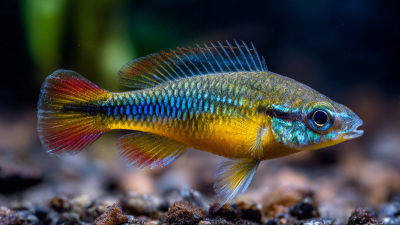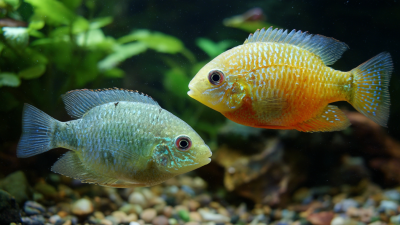Discover the Essential Fish Pet Supply Trends Driving Growth in the Aquatic Pet Market
The aquatic pet market is witnessing remarkable growth, driven by evolving consumer preferences and a surge in demand for specialized Fish Pet Supply products. According to a recent report by the American Pet Products Association, the pet industry is expected to exceed $100 billion in sales by 2025, with the aquatic segment contributing significantly to this trend. Factors such as the rising popularity of home aquariums, advancements in fish care technologies, and an increasing awareness of sustainable fishkeeping practices are fueling this growth. Furthermore, as more households include aquatic pets as part of their family, the demand for quality fish supplies—including food, filtration systems, and tank accessories—continues to rise. This dynamic environment presents opportunities for businesses to innovate and capture market share in the evolving landscape of Fish Pet Supply.

How to Choose the Right Fish Supplies for Your Aquatic Pets
When it comes to selecting the right fish supplies for your aquatic pets, understanding the current market trends is crucial. The tropical fish market, which was valued at $870 million in 2022, is projected to reach $1.36 billion by 2030, with a compound annual growth rate of 5.8% from 2024 to 2030. This growth hints at a rising interest among pet owners, with 67% of the population engaging in pet ownership. As such, it’s essential for buyers to consider quality supplies that cater to both the health and well-being of their aquatic pets.
Essential supplies include high-quality fish food, appropriate tank accessories, and water conditioners, which are vital in maintaining a healthy aquarium environment. The increase in online pet supply sales has also streamlined the purchasing process, allowing consumers to easily access a variety of products tailored to their aquatic needs.
By staying informed about these trends and selecting the right products, fish owners can ensure a thriving habitat for their pets, contributing to the overall growth and dynamism of the aquatic pet market.
How to Implement Sustainable Practices in Fish Pet Supply Sales
The aquatic pet market is experiencing a notable shift towards sustainability, with significant growth anticipated in the overall pet care sector. By 2024, the global pet care market is projected to reach a staggering $259.37 billion, with an encouraging forecast to grow to $427.75 billion by 2032. This expansion highlights the increasing importance of sustainable practices in fish pet supply sales, as consumers become more environmentally conscious.
A key aspect of this growth is the rise of sustainable pet products, which is expected to reach a market size of $35.1 billion by 2024. The sustainable pet product segment alone is projected to grow at a compound annual growth rate (CAGR) of 7.6% from 2025 to 2034. Retailers and suppliers in the fish pet care industry must prioritize the integration of eco-friendly materials and practices to cater to the evolving preferences of their consumers. Implementing sustainable sourcing, product lifecycle assessments, and waste reduction strategies can not only improve brand loyalty but also contribute significantly to the overall success of businesses in this thriving market.

How to Understand Consumer Preferences in the Aquatic Pet Market
Understanding consumer preferences in the aquatic pet market is crucial for businesses aiming to thrive in this growing segment. One key aspect to consider is the increasing demand for sustainable and eco-friendly products. Consumers are becoming more environmentally conscious and are inclined to choose brands that prioritize responsible sourcing and minimal ecological impact. This shift towards sustainability not only influences purchasing decisions but also fosters brand loyalty, making it essential for companies to align their offerings with these values.
Another trend to monitor is the rise in technological innovations in fish care and aquarium maintenance. Smart aquarium systems, water quality monitoring devices, and automated feeders cater to the needs of tech-savvy pet owners who seek convenience and efficiency. Understanding how these innovations resonate with consumers can guide businesses in developing products that enhance the aquatic pet experience. By paying attention to these evolving preferences, companies can effectively tap into the growth potential of the aquatic pet market while meeting the expectations of modern pet owners.
How to Innovate Product Offerings for Fish Enthusiasts
The aquatic pet market is witnessing significant growth, primarily driven by evolving consumer preferences and innovative product offerings for fish enthusiasts. As the global pet care market is projected to reach a value of $259.37 billion by 2024, it is crucial for businesses to adapt and cater to the diverse needs of fish owners. This trend is reflected in the booming fishing bait and lure market, valued at $4 billion in 2022 and expected to grow at a compound annual growth rate (CAGR) of 6.8% through 2030. Such growth underscores the increasing appetite for specialized products that enhance the fishing experience.
Innovation in product offerings is essential to capture the growing demographic of health-conscious consumers and sustainability advocates. The ready-to-eat seafood snack market is set to grow from $6.1 billion in 2024 to an impressive CAGR of 5.5% between 2025 and 2034, driven by the rising preference for protein-rich snacks. Additionally, the marine collagen market is also on an upward trajectory, anticipated to increase from $1.2623 billion in 2025 to $2.3162 billion by 2032, showcasing a consumer shift towards health-oriented aquatic products. Therefore, businesses that focus on producing innovative, sustainable, and nutritious offerings are likely to thrive in this dynamic market landscape.
Fish Pet Supply Trends Driving Growth in the Aquatic Pet Market
How to Leverage Online Platforms for Fish Supply Distribution
 As the aquatic pet market continues to flourish, leveraging online platforms for fish supply distribution has become crucial. E-commerce provides access to a broader customer base and allows businesses to showcase their products effectively. Building an engaging, user-friendly website can enhance the shopping experience, while social media channels can be used to connect with potential customers, share valuable content, and showcase captivating visuals of aquatic life.
As the aquatic pet market continues to flourish, leveraging online platforms for fish supply distribution has become crucial. E-commerce provides access to a broader customer base and allows businesses to showcase their products effectively. Building an engaging, user-friendly website can enhance the shopping experience, while social media channels can be used to connect with potential customers, share valuable content, and showcase captivating visuals of aquatic life.
Tip: Be active on platforms like Instagram and TikTok, where visuals reign supreme. Share high-quality images and videos of vibrant fish and stunning aquarium setups to captivate your audience. Encourage user-generated content by hosting contests that prompt your customers to share pictures of their own fish tanks.
Moreover, utilizing online marketplaces can increase exposure and simplify the buying process for customers. Offering a seamless checkout experience, including diverse payment options and efficient delivery services, will boost customer satisfaction and drive repeat purchases.
Tip: Consider implementing a subscription model for regular supplies like fish food or tank maintenance products. This not only ensures recurring revenue but also fosters customer loyalty as they anticipate the arrival of their products each month.
Related Posts
-

Essential Guide to Choosing the Best Fish Pet Supply for Your Aquatic Friends
-

How to Choose the Best Aquarium Decorations That Enhance Your Fish’s Well-being
-

10 Compelling Reasons to Buy Pet Products Online Today
-

How to Choose the Right Aquarium Stand for Your Tank: Top Features and Industry Insights
-

15 Genius Tips for Choosing the Best Fish Aquarium Products
-

Top 10 Online Pet Supply Manufacturers from China at the 137th Canton Fair
Copyright © 2021 Payless Pet Products - All Rights Reserved.